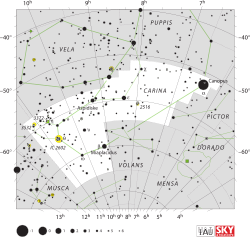LHS 288
| Observation data Epoch J2000 Equinox J2000 | |
|---|---|
| Constellation | Carina |
| Right ascension | 10h 44m 21.320s[1] |
| Declination | −61° 12′ 35.44″[1] |
| Apparent magnitude (V) | 13.92[2] |
| Characteristics | |
| Spectral type | M5V[3] (M4[1]) |
| B−V color index | 1.82[2] |
| V−R color index | 1.59[1] |
| R−I color index | 2.02[1] |
| J−H color index | 0.442[1] |
| J−K color index | 0.764[1] |
| Astrometry | |
| Proper motion (μ) | RA: −334[1] mas/yr Dec.: 1626[1] mas/yr |
| Parallax (π) | 208.95 ± 2.73[3] mas |
| Distance | 15.6 ± 0.2 ly (4.79 ± 0.06 pc) |
| Absolute magnitude (MV) | 15.52α |
| Other designations | |
| Database references | |
| SIMBAD | data |

Carina Constellation.
LHS 288 (Luyten 143-23) is a red dwarf 15.6 light years from the Sun, the closest in the constellation Carina (near Eta Carinae). It is far too faint to be seen with the unaided eye, with an apparent magnitude of 13.92.
Recent studies suggest it may harbour a planet with a mass as small as 2.4 Jupiter, but the possibility that it passed over an undetected faint star could not be eliminated[4].
See also
References
- 1 2 3 4 5 6 7 8 9 "GJ 3618". SIMBAD. Centre de données astronomiques de Strasbourg. Retrieved 3 Jun 2017.
- 1 2 "Nearby Stars, Preliminary 3rd Version (Gliese+ 1991)".
- 1 2 Henry, T. J.; Jao, Wei-Chun; Subasavage, John P.; Beaulieu, Thomas D.; Ianna, Philip A.; Costa, Edgardo; Méndez, René A. (2006). "The Solar Neighborhood. XVII. Parallax Results from the CTIOPI 0.9 m Program: 20 New Members of the RECONS 10 Parsec Sample". The Astronomical Journal. 132 (6): 2360–2371. arXiv:astro-ph/0608230. Bibcode:2006AJ....132.2360H. doi:10.1086/508233.
- ↑ "Possible Astrometric Perturbation of LHS 288". Bibcode:2007AAS...20925416B.
External links
This article is issued from
Wikipedia.
The text is licensed under Creative Commons - Attribution - Sharealike.
Additional terms may apply for the media files.